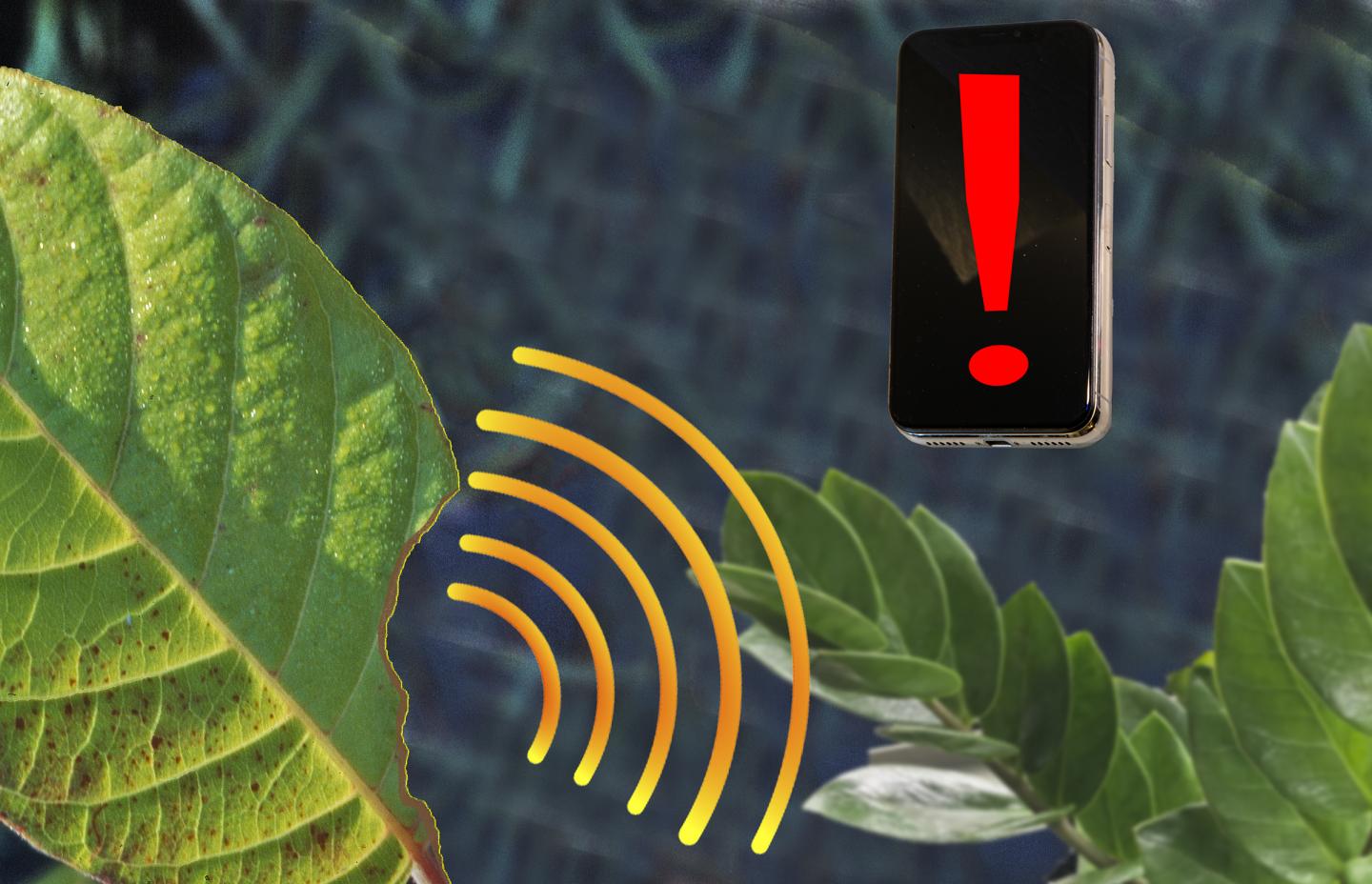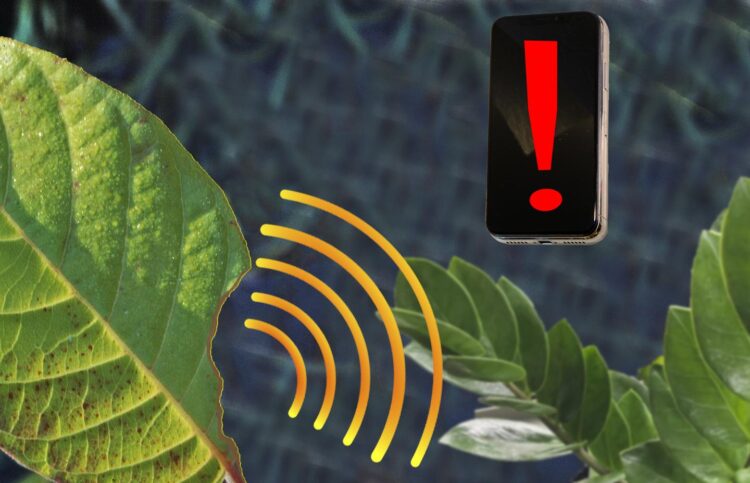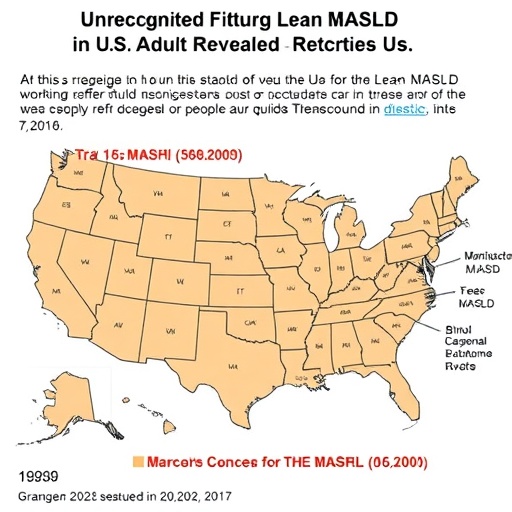New nanobionic approach allows scientists to study the communication within plants, providing valuable insights to improve crop yields

Credit: Felice C. Frankel
- Sensors can intercept distress signals within plants to reveal how they respond to different types of stress
- Plant responses can be sent directly to remote electronic devices such as cell phones, allowing remote, real-time tracking
- Nanobionic approach has a range of applications including studying how to improve crop yield in urban farms
- The technology can potentially be applied to all types of plants
Singapore, 16 April 2020 – Researchers from Massachusetts Institute of Technology (MIT), Singapore-MIT Alliance for Research and Technology (SMART), MIT’s research enterprise in Singapore, and Temasek Life Sciences Laboratory (TLL) have developed a way to study and track the internal communication of living plants using carbon nanotube sensors that can be embedded in plant leaves.
The sensors can report on plants’ signalling waves to reveal how they respond to stresses such as injury, infection, heat and light damage, providing valuable real-time insights for engineering plants to maximise crop yield.
The new nanobionic approach is explained in a paper titled “Real-time Detection of Wound-Induced H2O2 Signalling Waves in Plants with Optical Nanosensors” published in the prestigious online scientific journal Nature Plants. It uses sensors to intercept the hydrogen peroxide signals that plants use to communicate internally and displays the data on remote electronic devices such as cell phones, allowing agricultural scientists to remotely keep track of plant health in real time.
“Plants have a very sophisticated form of internal communication, which we can now observe for the first time. That means that in real time, we can see a living plant’s response, communicating the specific type of stress that it’s experiencing,” says Michael Strano, co-lead Principal Investigator at Disruptive & Sustainable Technologies for Agricultural Precision (DiSTAP), an Interdisciplinary Research Group under SMART. Professor Strano, who is the senior author of the paper, is also a Carbon P. Dubbs Professor of Chemical Engineering at MIT.
The technology can provide much-needed data to inform a range of agricultural applications such as screening different species of plants for their ability to resist mechanical damage, light, heat, and other forms of stress, or study how different species respond to pathogens. It can also be used to study how plants respond to different growing conditions in urban farms.
“Plants that grow at high density are prone to shade avoidance, where they divert resources into growing taller, instead of putting energy into producing crops, lowering overall crop yield,” says Professor Strano. “Our sensor allows us to intercept that stress signal and to understand exactly the conditions and the mechanism that are happening upstream and downstream in the plant that gives rise to the shade avoidance, thus leading to fuller crops.”
Traditionally, molecular biology research has been limited to only specific plants that are amenable to genetic manipulation, but this new technology can potentially be applied to any plant. Professor Strano’s team has already successfully used the approach in comparing eight different species including spinach, strawberry plants and arugula, and it could work for many more.
Funded by the National Research Foundation (NRF) Singapore, the Agency for Science, Technology and Research (A*STAR), and the U.S. Department of Energy Computational Science Graduate Fellowship Program, the study set out to embed sensors into plants that would report back on the plants’ health status. The research team used a method called lipid exchange envelope penetration (LEEP), developed previously by Professor Strano’s lab, to incorporate the sensors into plant leaves.
“I was training myself to get familiarized with the technique, and in the process of the training I accidentally inflicted a wound on the plant. Then I saw this evolution of the hydrogen peroxide signal,” says the paper’s lead author and MIT graduate student Tedrick Thomas Salim Lew.
The release of hydrogen peroxide triggers calcium release among adjacent plant cells, stimulating them to release more hydrogen peroxide and creating a wave of distress signals along the leaf. While the wave of hydrogen peroxide stimulates plants to produce secondary metabolites that can help repair damage, these metabolites are also often the source of the flavours we want in our edible plants. Manipulating this can help farmers enhance the taste of the plants we eat while optimising plant yield.
###
About SMART Disruptive & Sustainable Technologies for Agricultural Precision (DiSTAP)
DiSTAP is one of the five Interdisciplinary Research Groups (IRGs) of the Singapore-MIT Alliance for Research and Technology (SMART). The DiSTAP programme addresses deep problems in food production in Singapore and the world by developing a suite of impactful and novel analytical, genetic and biosynthetic technologies. The goal is to fundamentally change how plant biosynthetic pathways are discovered, monitored, engineered and ultimately translated to meet the global demand for food and nutrients. Scientists from Massachusetts Institute of Technology (MIT), Temasek Life Sciences Laboratory (TLL), Nanyang Technological University (NTU) and National University of Singapore (NUS) are collaboratively: developing new tools for the continuous measurement of important plant metabolites and hormones for novel discovery, deeper understanding and control of plant biosynthetic pathways in ways not yet possible, especially in the context of green leafy vegetables; leveraging these new techniques to engineer plants with highly desirable properties for global food security, including high yield density production, drought and pathogen resistance and biosynthesis of high-value commercial products; developing tools for producing hydrophobic food components in industry-relevant microbes; developing novel microbial and enzymatic technologies to produce volatile organic compounds that can protect and/or promote growth of leafy vegetables; and applying these technologies to improve urban farming.
For more information, please log on to: http://distap.
About Singapore-MIT Alliance for Research and Technology (SMART)
Singapore-MIT Alliance for Research and Technology (SMART) is MIT’s Research Enterprise in Singapore, established by the Massachusetts Institute of Technology (MIT) in partnership with the National Research Foundation of Singapore (NRF) since 2007. SMART is the first entity in the Campus for Research Excellence and Technological Enterprise (CREATE) developed by NRF. SMART serves as an intellectual and innovation hub for research interactions between MIT and Singapore. Cutting-edge research projects in areas of interest to both Singapore and MIT are undertaken at SMART. SMART currently comprises an Innovation Centre and five Interdisciplinary Research Groups (IRGs): Antimicrobial Resistance (AMR), Critical Analytics for Manufacturing Personalized-Medicine (CAMP), Disruptive & Sustainable Technologies for Agricultural Precision (DiSTAP), Future Urban Mobility (FM) and Low Energy Electronic Systems (LEES).
SMART research is funded by the National Research Foundation Singapore under the CREATE programme. For more information, please visit – http://smart.
For media queries, please contact:
Tazkira Sattar
[email protected]
+65 8280 3055
Media Contact
Tazkira Sattar
[email protected]
Original Source
https:/
Related Journal Article
http://dx.





